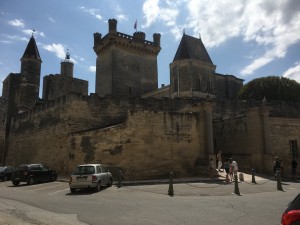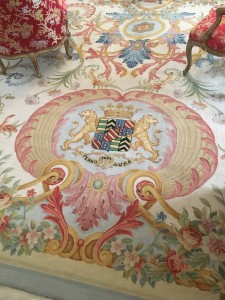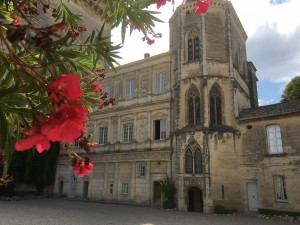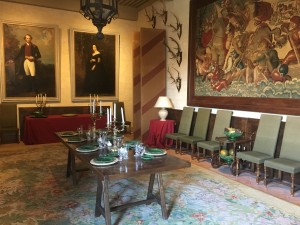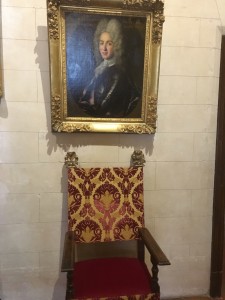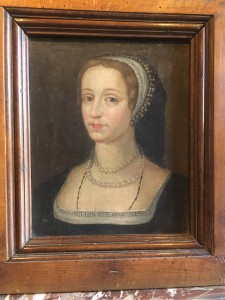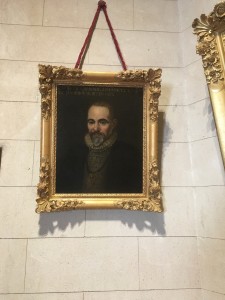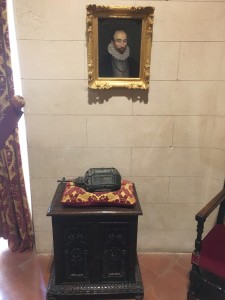When Proust was travelling ‘the Guermantes Way’ in the 1890s, charming the aristocratic hostesses of the Faubourg Saint-Germain and frequenting their salons and soirées, one of the families he encountered was that of Crussol d’Uzès. The duc d’Uzès (creation 1565) was the second most senior duke in France, only a short head behind the duc de La Trémoïlle (1563). That line died out in 1933, so the duc d’Uzès has since been France’s premier duke and peer.
The Crussols had been intimates of the royal family since at least the fourteenth century, the holders of high office and active on many a campaign. Their motto, indeed, is Ferro non auro, ‘By steel, not gold’. Louis XVIII once expressed his surprise that none of them had ever been a Marshal of France. ‘Sire,’ replied the duke, ‘nous nous faisons tuer avant (we always seem to get ourselves killed beforehand).’
The first part of the family name recalls their long-abandoned stronghold in the Rhône valley, opposite Valence, while the second marks their lordship of Uzès, an ancient city in Occitania. They also maintained an hôtel in the rue Montmartre, for these places are in the deep south, far indeed from Paris and the court. ‘Uzès!’ said André Malraux, General de Gaulle’s Minister of Culture and a friend of the family, ‘but that’s even further away than China!’
The dominant member of the family in Proust’s time was the ‘Grande Duchesse’ (born Anne de Rochechouart de Mortemart), a talented sculptress who contributed the figure of Saint Hubert to Sacré Coeur, a yachtswoman, a feminist and a fanatical rider-to-hounds; also the first woman in France to hold a driving licence (1889) and the first to receive a fine for speeding (1893), after her Delahaye had topped 15km per hour in the Bois de Boulogne. Whilst admiring this formidable lady for her varied achievements, Proust was unable to detect in her any of the famed ‘Mortemart wit’. She was, however, the granddaughter and sole heiress of the Veuve Cliquot, and thus introduced an intoxicating and enriching dose of bourgeois blood to the Crussol line.
Determined that her son Jacques should avoid a more flagrant mésalliance – he ‘became infatuated with the cocotte Émilienne d’Alençon, who was exhibiting a troupe of performing white rabbits – though nobody had eyes for the rabbits’ – she packed him off to Africa, where he died of enteric fever in 1893. The last straw had been Émilienne’s disporting herself in public with the family jewels. The episode made an impression on Proust, for in his Recherche it apparently ‘suggested Saint-Loup’s exile to Morocco as punishment for his extravagant gifts to Rachel’. (George Painter, Marcel Proust: A Biography, I, New York 1959, pp.163-4; http://www.uzes.com/.)
Though it is usual to pronounce the final ’s’ in Uzès, Proust discovered that the gratin had their own rendering of this and other famous names, whether from long tradition or as a way of enhancing their exclusivity. In Sodome et Gomorrhe (Bouquin edition II, Paris 1987, p.665), the snobbish outsider, Mme de Cambremer, is disconcerted to hear an acquaintance speak of ‘ma tante d’Uzai’ and of ‘mon onk de Rouan’, not immediately recognising the famous names that she herself pronounced ‘Uzès’ and ‘Rohan’. The very next day, when a friend refers to a bust of the duchesse d’Uzès, Mme de Cambremer is delighted to correct her. ‘Vous pourriez au moins prononcer comme il faut (you could at least pronounce it correctly),’ she says haughtily: ‘Mame d’Uzai.’
The snobbery that Proust encountered in the Faubourg – and documented in his novels – was breathtaking. The present duke, however, is a man of the people. I am reliably informed that the taxi that conveys him from Nîmes airport for his monthly visits to Uzès is instructed to call first at McDonald’s restaurant, whose ‘drive-thru’ facility is conveniently located on the edge of the modern city.
The Duché d’Uzès: An Appreciation
His modest address in the Place du Duché, Uzès, hardly prepares one for the grand residence of France’s premier duke and peer. Approaching through a narrow side street, one glimpses a turret on a tall building ahead, a fluttering banner, an elaborate escutcheon worked into the brown tiles of a steep roof. Emerging into the Place, one is suddenly confronted by a full-blown castle in the middle of the historic city, one that, most unusually, is occupied by its original family as it has been for a thousand years.
The three elements to the castle are instantly laid bare in the main courtyard that is accessed through a door from the Place. The oldest and most prominent of these is La Tour Bermond, a massive square keep, fifty metres high, named for the lord of Uzès who built it in the twelfth century.
Then there are the fourteenth-century ramparts, projecting from one side of the keep, which were added by lord Robert after his elevation to vicomte in 1328. Robert’s apartments, the so-called ‘vicomté’, which are built into these ramparts, are disguised behind a nineteenth-century façade, though with a tall hexagonal turret at one end.
Finally, another medieval range that projected from the keep was aggrandised in fine Renaissance style by the Crussols, for Charles de Crussol, Grand Pantryman of France, had in 1486 married Simone d’Uzès, the prized heiress to Bermond and Robert’s line. Their grandson, Antoine, became the first duc d’Uzès in 1565. An associate of the sinister Catherine de’ Medici and a trimmer, renouncing his Protestantism in timely fashion in 1572, Antoine employed a sensitive and learned architect on his renovated apartments, ‘le Duché’, the striking façade of which features Doric, Ionian and Corinthian columns in layers for each floor.
His father Charles had already paved the way with the splendid vaulted staircase of c.1515, quite taxing to any but the nimble, that now leads to these rooms. The first of them is a hallway containing two exceptional treasures, laid out on cushions: a helmet from the time of Joan of Arc, in excellent condition; and – a great curiosity – a lamp said to be a relic from the Crusades, lords of Uzès having participated, as vassals of the Counts of Toulouse, in the Fourth and probably also the First Crusades. It seems to me very rare that a family should preserve any artefact of so early a date.
Crussols in ruffs and lace gaze down from the walls (including the Grand Pantryman Louis with his trim beard, last of the family from whom I myself am directly descended). The room is simply furnished, even austere, as is fitting in a living fortress: ‘In our halls is hung armoury of the invincible knights of old,’ as Wordsworth puts it. The theme is continued in an adjoining vestibule, where there are portraits of more recent Crussols, including a full-length one of the present duke, a sleek and elegant figure in a dinner jacket, his arms casually folded.
These rooms lead to a grand ‘state’ room, a Wedgwood-blue salon with a lot of white-and-blue porcelain and Louis Quinze chairs with red and gold covers. Despite the warm colours, there is a coldness to rooms of such conventional formality, and the modest fireplace tucked into one corner would hardly have raised the temperature. I was struck, however, by the elaborate carpet commissioned by the present duke that bears his achievement of arms, with its multiple quarterings, which, indeed, is ubiquitous throughout the castle; and was tempted by the glimpse of a more intimate room beyond, all in red, into which one is not invited.
Instead, one is steered through a long, cool passage into one of the many bedrooms that lead off it – the ‘Yellow Room’, with its memories of ‘la Grande Duchesse’ – and the dining-room, where an immaculate Aubusson tapestry is framed by hunting trophies (hers, probably). A large, fifteenth-century triptych depicting members of the royal house hangs nonchalantly above a sideboard, on which a portrait of that precious commodity, Simone d’Uzès, has been propped – a happy-looking girl with rosy cheeks and a hint of a smile. The fifteenth-century chapel beyond was refurbished in 1838 and includes a colourful wall-painting of the family’s heraldry.
There is only a small, formal garden at the back of the Duché. The park, watered by the river Alzon, is across the city, outside the walls, and is a public amenity.
The charming and expertly trained guides at le Duché, looking like matelots in their white denims and T-shirts, are as well-versed in heraldry and genealogy as any Guermantes. Le Duché is a carefully managed stage-set, a romantic anachronism, yet is perfectly pitched at anyone, like me, who thrills in Grand Pantrymen and crusader lamps.
